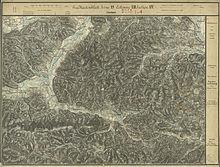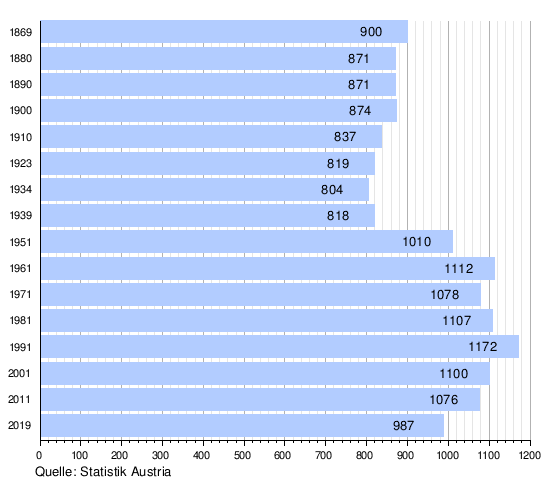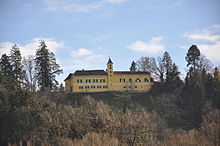Arnfels
|
market community Arnfels
|
||
|---|---|---|
| coat of arms | Austria map | |
|
|
||
| Basic data | ||
| Country: | Austria | |
| State : | Styria | |
| Political District : | Leibnitz | |
| License plate : | LB | |
| Surface: | 4.19 km² | |
| Coordinates : | 46 ° 41 ′ N , 15 ° 24 ′ E | |
| Height : | 317 m above sea level A. | |
| Residents : | 984 (January 1, 2020) | |
| Postal code : | 8454 | |
| Area code : | 03455 | |
| Community code : | 6 10 02 | |
| NUTS region | AT225 | |
| Address of the municipal administration: |
Hauptplatz 33 8454 Arnfels |
|
| Website: | ||
| politics | ||
| Mayor : | Karl Habisch (List KARL) | |
|
Municipal Council : (2015) (15 members) |
||
| Location of Arnfels in the Leibnitz district | ||
| Source: Municipal data from Statistics Austria | ||
Arnfels (Slovenian Arnež ) is a market town with 984 inhabitants (as of January 1, 2020) in the judicial district or district of Leibnitz in southern Styria . It is located on the Pößnitzbach and near the border with Slovenia.
geography
Community structure
The municipality comprises two localities and cadastral communities of the same name (residents as of January 1, 2020):
- Arnfels (813 inhabitants; 228.58 ha)
- Maltschach (171 Ew .; 190.83 ha)
Neighboring communities
| Sankt Johann in the Saggau Valley | ||
| Oberhaag |

|
Leutschach on the Wine Route |
| Oberhaag |
geology
Geologically, the rocks of Arnfels and the surrounding area belong to the Possruck area and have been scientifically investigated.
history

The area near Arnfels was owned by the Spanheimers in the 11th century . It is therefore assumed that one of their servants built Arnfels Castle, with the settlement built by German colonists at the foot of the mountain receiving the same name. Based on previous research, the year 1150 can be assumed to be the historical hour of birth of Arnfels. The market, originally a Burgundy settlement , was first mentioned in 1280 .
The Castle Arnfels was already around 1212 as castrum Arnuelse known and initially was owned by the Lords of Mureck but switched in the following centuries several owners. The name Arnfels could also refer to the builder or first owner of the castle: "Fels des Arno" = Arnfels. Arnfels was raised to market as early as 1278 .
Two major devastations are striking in the local history: On the one hand, the devastation caused by the invading Turks in 1532 and, on the other hand, a conflagration that raged in the market in 1825.
On May 20, 1580 Barbara Striglin became the first victim of the newly appointed country professional Jakob Bithner. He had been called from Jena to Styria, his behavior led to an unprecedented wave of witch persecution. The woman was burned at the stake as a "butter witch" after two weeks of torture . She was accused of conjuring up thunderstorms, making the devil a child, turning into animals and making butter inedible.
Arnfels has been an independent parish since 1788 . Before that, like most of the surrounding villages, it belonged to the parish of St. Johann in the Saggautal . As a result of the reforms of Emperor Joseph II , large parish areas were converted into several parishes in order to ensure better pastoral care for the population. In contrast to other churches , the parish church Maria am Grüne Waasen , which faces south, was built between 1714 and 1717 in place of a previous church from the 15th century.
In the Middle Ages, trade and commerce flourished, as the market was on the so-called Radkersburger Weinstrasse , via which heavily loaded wagons of fruit and wine drove to Upper Styria from Bad Radkersburg via Arnfels, Voitsberg and the Stubalpe . Iron and salt were brought back to the lowlands .
A district court was set up in Arnfels around 1850 . This court was closed in 1976. Since then, Arnfels has belonged to the district of the Leibnitz District Court.
Population development

Culture and sights
- Arnfels Castle is located on a ridge above the market and is mentioned in a document around 1200. In 1424 it was rebuilt after a fire and renovated in 1976. Only the northern half has been preserved, which was changed by a renovation in 1916. An eastern tower dates from 1693. From 1681 to 1912 it was owned by the Counts of Schönborn .
- The former Margarethenkirche was abandoned in the 16th century, its building demolished in the 18th century.
- Parish church Arnfels : The parish church with the patronage of the birth of Mary was built in the 15th century as Maria am Waasen. A new building took place between 1714 and 1717, the extensive interior furnishings date from the 17th to the 19th centuries.
- In the townscape there is a statue of Johann Nepomuk on an old arched stone bridge over the Pößnitzbach, the chronogram of which refers to the year 1706.
- A stone statue on the road to St. Johann dates from 1656. The monument guide contains references to a number of other buildings.
- Cultural highlights are the hobby artist market, which takes place in September and attracts up to 18,000 visitors annually, the Arnfelser Schlossspiele, several theater and concert events as well as exhibitions organized by various associations and private individuals.
- Two choirs, the Arnfels church choir and the Arkadia Arnfels choir, as well as the Arnfels Vocal Quartet, make a major contribution to the cultural life in Arnfels and the surrounding area with their performances, events and activities (Advent singing, annual concerts, youth choir, caroling events, choir projects).
- An important cultural point in Arnfels is the market music band (MMK for short). MMK Arnfels has existed since 1924. At the moment it is under the direction of chairman Christian Lederhaas and conductor Karl Miheu. The Robert Stolz Medal was awarded twice and the Styrian Panther three times. Rehearsals have been taking place in the specially built "House of Music" since November 17, 2006.
Sports
Arnfels has a leisure center with an outdoor pool (two pools), buffet, beach volleyball court, a tennis hall, a football stadium and the border sports facility, which is used with its two halls for various events.
Economy and Infrastructure
traffic
Arnfels is located on the South Styrian border road B 69.
education
The place became an important school center with elementary / secondary / new middle school, state vocational school for car mechanics and car electricians as well as a relocation of the HTBLA Kaindorf with the higher department for mechatronics.
tourism
Together with Ehrenhausen an der Weinstrasse, Leutschach an der Weinstrasse, Oberhaag and Straß in Styria, the municipality forms the tourism association “The Southern Styrian Wine Route”. Its headquarters are in Leutschach on the Weinstrasse .
politics
The municipal council consists of 15 members. The result of the 2015 municipal council election results in the following distribution of mandates:
However, the curiosity arises that four of the five seats on the KARL list will remain empty, since only the candidate list leader Karl Habisch was nominated as the only candidate on the list of candidates.
| Political party | 2015 | 2010 | 2005 | 2000 | ||||||||
|---|---|---|---|---|---|---|---|---|---|---|---|---|
| be right | % | Mandates | St. | % | M. | St. | % | M. | St. | % | M. | |
| ÖVP | 213 | 32 | 5 | 426 | 61 | 10 | 361 | 51 | 8th | 357 | 50 | 8th |
| SPÖ | 128 | 19th | 3 | 85 | 12 | 2 | 170 | 24 | 4th | 129 | 18th | 3 |
| FPÖ | 56 | 9 | 1 | 26th | 4th | 0 | 33 | 5 | 0 | 117 | 16 | 2 |
| KARL (Karl Habisch) | 192 | 29 | 5 | not running | not running | not running | ||||||
| Future of Arnfels | 69 | 10 | 1 | 102 | 14th | 2 | not running | not running | ||||
| Arnfels 2000 | not running | 65 | 9 | 1 | 143 | 20th | 3 | 108 | 15th | 2 | ||
| Eligible voters | 847 | 880 | 875 | 827 | ||||||||
| voter turnout | 79% | 81% | 82% | 87% | ||||||||
mayor
- until 2010 Johann Held (ÖVP)
- 2010–2015 Josef Gaber (ÖVP)
- since 2015 Karl Habisch (List KARL)
coat of arms
The market town of Arnfels received the privilege of bearing a coat of arms on October 9, 1517 from Emperor Maximilian I.
Blazon (coat of arms description):
- "In a red shield there is a golden eagle, on the middle one of three interlocking golden crags directed towards flight."
Personalities
Honorary citizen
- 1987: Josef Krainer (1930–2016), Governor of Styria 1980–1996
Sons and daughters of the church
- Joseph Ludwig Bayer (1803–1882), landowner and politician, member of the state parliament and the Austrian House of Representatives
- Felix Machatschki (1895–1970), mineralogist
- Gerald Brettschuh (* 1941), painter and graphic artist
Personalities associated with the community
- Camillo Bregant (1879–1956), officer
- Karl Frodl (1919–2007), ÖVP politician
Web links
- 61002 - Arnfels. Community data, Statistics Austria .
- Arnfels market town
Individual evidence
- ↑ Statistics Austria: Population on January 1st, 2020 by locality (area status on January 1st, 2020) , ( CSV )
- ^ Franz Angel: Rocks in the area around Leutschach and Arnfels in Styria . Yearbook of the Federal Geological Institute, Volume 83, Vienna 1933. Pages 5–18. (PDF; 620 kB)
- ↑ Entry about Castle Arnfels on Burgen-Austria
- ↑ Robert Preis : The butter witch burns. Where the great witch craze began. In: 111 gruesome places in Styria that you have to see. Verlag emons :, Graz 2018. ISBN 978-3-7408-0445-9 . P. 14.
- ↑ Ordinance of the Federal Government of July 6, 1976 No. 353/1976, Federal Law Gazette for the Republic of Austria of July 15, 1976, 108th item.
- ^ Kurt Woisetschläger, Peter Krenn: Dehio Handbook - Die Kunstdenkmäler Österreichs: Styria (excluding Graz). Topographical inventory of monuments, ed. from the Federal Monuments Office, Department for Monument Research. Publisher Anton Schroll. Vienna 1982. ISBN 3-7031-0532-1 . Pages 20–22.
- ^ Grazer Zeitung , Official Gazette for Styria. December 30, 2014, 210th year, 52nd piece. No. 302. ZDB -ID 1291268-2 pp. 624-625.
- ↑ Kleine Zeitung of March 24, 2015: A third of the seats won single-handedly , accessed on May 30, 2015
- ^ Municipality of Arnfels: Election announcement - election proposals ( Memento of May 30, 2015 in the Internet Archive ) (PDF document, 23 kB), accessed on May 30, 2015
- ↑ My week of April 17, 2015: Karl Habisch was elected mayor of Arnfels , accessed on May 30, 2015
- ↑ Kleine Zeitung of April 11, 2015: Karl Habisch becomes the new mayor of Arnfels , accessed on May 30, 2015
- ↑ Leibnitz Aktuell, No. 6 (1987), p. 8.











